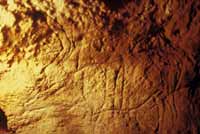 |
One of the outcomes of my research on transegalitarian
societies has been a growing awareness of the important role
that secret societies play in the creation of socioeconomic
inequalities and political centralization. Since strong
arguments can be advanced that many Upper Paleolithic societies
in Southwest Europe were transegalitarian societies with
significant inequalities, I, together with D’Ann Owens, began to
explore the possible implications of transegalitarian dynamics
for the interpretations of Upper Paleolithic painted caves.
Specifically, we concluded that these painted caves most likely
were used for the most costly and high level secret society
initiations and ceremonies. Our research was based on
theoretical considerations and available information in the
literature (see Owens and Hayden 1997). In 2001, I began to
extend this research to deal with the direct analysis of the
physical viewing contexts and other key attributes of cave art
images to evaluate the notion that caves might have been used
for secret society rituals as opposed to individual shamanistic
experiences, hunting magic, or tribal initiations.

Engraved Cervid
References:
- 2005
- Review:“Lascaux, Le Geste, L’Espace, et Le Temps,” by N.
Aujoulat; and “Chauvet Cave,” by Jean Clottes. American
Antiquity 70:384–388.
- 1997 Owens, D’Ann, and B. Hayden.
- “Prehistoric rites of passage: a comparative study of
transegalitarian hunter-gatherers.” Journal of
Anthropological Archaeology 16:121–161.
|
 |